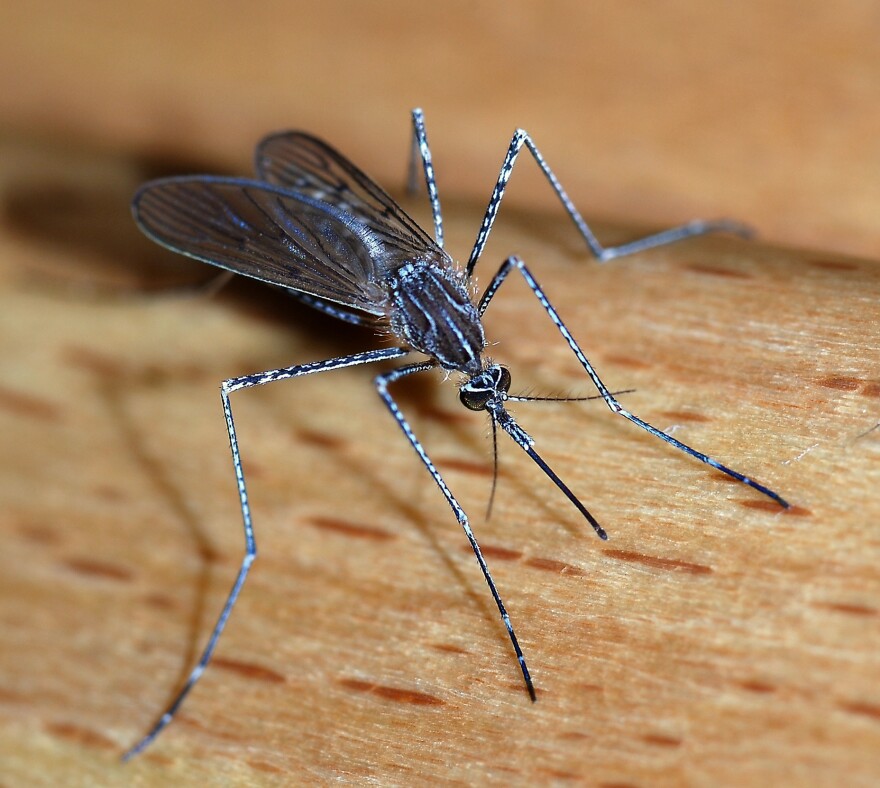SCARBOROUGH, Maine - Lurking in Maine's forests, swamps and even backyards are potentially serious diseases. Deer ticks are a source of at least five diseases in the state. Mosquitoes are the source for two others: West Nile Virus and Eastern Equine Encephalitis, or EEE. Their incidence in humans is rare in Maine, but researchers at Maine Medical Center's Vector-borne Disease Lab know they infect animals around us. As Patty Wight reports in the second part of her two-part series, their job is to find out why, and to detect when the viruses emerge in humans.
Some people collect baseball cards or coins. Vector Ecologist Charles Lubelczyk collects ticks and mosquitoes. From spring to fall, and even sometimes in the winter, he drives to 32 sites stretching from York to Aroostook County looking for the little guys.

On this day, he's collecting mosquitoes in Lebanon, a geographically typical, lowland area, "where you have a lot of post-agriculture, where now it's coming back to forested areas," he says. "But there's also a lot of individual homes that are coming into these areas, which from a public health perspective, would introduce a lot of people and livestock into areas where you have these viruses naturally cycling."
Viruses like West Nile and Eastern Equine Encephalitis - EEE. "And these viruses probably naturally cycle every year at some low level, going on silently in nature," Lubelczyk says. "And with Eastern and West Nile, the natural mortality occurs mostly in bird populations."
Maine has only one reported human case of West Nile, from 2012. But Lubelczyk suspects the incidence is much higher because West Nile tends to be a milder disease that behaves like the flu, and therefore goes unreported. EEE is much more serious, causing 30 percent of those infected to die, and leaving half of its survivors with permanent neurological damage.
There have been no confirmed human cases of EEE in Maine, but one was confirmed recently in Conway, New Hampshire. Here in Maine, Lubelczyk says there were two big outbreaks in 2009 and 2013 among horses, llamas, and pheasants.
"You know, we have a lot of questions why Eastern Equine Encephalitis is ramping up region wide," he says. "Twenty years ago it wasn't as much of an issue in the Northeast, and now it is."
He pulls off a busy road just past some houses and walks into a small patch of forested wetland - the preferred location for mosquitoes that carry EEE. A bunch of black plastic cubes are spread on the ground, with one side open. "This actually acts as a natural cavity that a lot of mosquitoes would like to spend their day in," he says - kind of like a hollow log.
To extract the mosquitoes in them, Lubelczyk uses a handheld vacuum he made himself. "This sort of Rube Goldberg-ish kind of contraption that looks like a large PVC pipe with a bit of stovepipe, a large battery, and then we get to use panty hose."
The panty hose are stretched out over the end of the stovepipe to act as a net to catch the mosquitoes. Lubelczyk fires it up, then suctions out each box, tapping each one to make sure all the mosquitoes are captured. After Lubelczyk vacuums out each box, he pulls out the panty hose, which can hold dozens of mosquitoes at a time, then stuffs it into a small plastic container. "This is the only time I can truthfully say I'm getting runs in my nylons," he jokes.
Lubelczyck will bring the mosquitoes back to the Vector-borne Disease Lab for identification. There are 45 species of mosquitoes in Maine, but only seven or eight are vectors, or sources, of EEE. After they're identified, they're sent to the state for analysis.
Lubelczyk says there are more questions than answers when it comes to these viruses, but climate change and heavy rainfall have likely contributed to outbreaks. The lab is also trying to solve another mystery: Why are animals like birds, deer, and moose contracting these diseases at a much higher rate than humans?
"Because mosquitoes don't differentiate between deer, moose, and us - we're all the same to them," he says. "You know, they think of us as big, respiring mammals that have a lot of blood in us and we're all equally attractive. But why are deer and moose being exposed, but people don't seem to be showing as many symptoms?"
With no human treatment available for West Nile and EEE, Lubelczyk is vigilant at all times. "You actually have one on your forehead right now," he points out. "As a public health message, I should warn you to get that mosquito off" - because he knows these viruses are brewing, and he and others at the Vector-borne Disease Lab intend to find them as soon as they strike in Maine.




